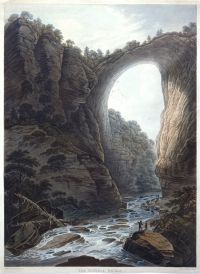Natural Bridge (Engraving)
Artist/Maker: J.C. Stadler (active early 19th c.), engraver, after William Roberts (active early 19th c.)
Created: 1808
Origin/Purchase: United States
Materials: colored aquatint
Dimensions: 69.2 × 52.1 (27 1/4 × 20 1/2 in.)
Provenance: Thomas Jefferson Foundation
Historical Notes: Jefferson considered the Natural Bridge and the passage of the Potomac River through the Blue Ridge Mountains at Harpers Ferry to be two of the most incredible natural sites in America and described them as "monuments of a war between rivers and mountains, which must have shaken the earth to its center."[1] While President, Jefferson received oil paintings of the two wonders as a gift from the artist William Roberts, who also sent two copies of his engraving of the Natural Bridge. The two paintings hung in Monticello's Dining Room alongside the Coalbrookdale Bridge, England's feat of engineering, and Niagara Falls, another of America's natural wonders. Neither the oil paintings nor Jefferson's copies of the engravings are located.[2]
Little is known of Roberts's life and work, but he referred to himself as a Virginian and met Jefferson at least twice. The two were first introduced in Europe in 1786 by the naturalist Michel Guillaume Jean de Crèvecoeur, and it seems likely that Jefferson suggested Harpers Ferry and the Natural Bridge as subjects for Roberts's work.[3] Jefferson described both places in his Notes on the State of Virginia, and he encouraged artists such as John Trumbull and Maria Cosway to paint them.
In Notes on the State of Virginia Jefferson praised the Natural Bridge as "the most sublime of Nature's works."[4] It was a site well known to him: he purchased it and the surrounding 157-acre tract in 1774 and owned it until his death. He visited the Natural Bridge at least four times.[5] On his first visit in 1767, he sketched the bridge and recorded its dimensions and setting on the inside back cover of his memorandum book.[6] These notes were the basis for his famous description in Notes of the bridge's sublime qualities:
It is impossible for the emotions, arising from the sublime, to be felt beyond what they are here: so beautiful an arch, so elevated, so light, and springing, as it were, up to heaven, the rapture of the Spectator is really indiscribable![7]
Jefferson shared his admiration for the bridge with his grandchildren, two of whom he took to see it on an adventurous journey in 1817. He often considered building a "little hermitage" there.[8] Although he attempted to sell the bridge during a financially difficult year, he later decided never to part with the property. "I view it," he wrote, "in some degree as a public trust, and would on no consideration permit the bridge to be injured, defaced or masked from public view."[9]
- Text from Stein, Worlds, 190
References
- ^ Notes, ed. Peden, 19-20.
- ^ In 1942, Mrs. Henry K. Dooley, of San Juan, Puerto Rico, reportedly owned Jefferson's painting of The Passage of the Potomac Through the Blue Ridge. Efforts to locate Mrs. Dooley or the painting have been unsuccessful.
- ^ Roberts to Jefferson, July 18, 1804, Thomas Jefferson Papers, Massachusetts Historical Society (transcription available at Founders Online); Roberts to Jefferson, February 26, 1808, ibid. (transcription available at Founders Online); Barbara Batson, "Virginia Landscapes by William Roberts," Journal of Early Southern Decorative Arts 10 (November 1984): 35-36.
- ^ Notes, ed. Peden, 24.
- ^ After 1767, Jefferson visited the bridge again in 1815, 1817, and 1821, and possibly in 1781. The Natural Bridge tract was sold from Jefferson's estate in 1833.
- ^ MB, 1767, at the beginning of his cash accounts. Transcription and editorial notes available at Founders Online.
- ^ Notes, ed. Peden, 25. For discussion of Jefferson's views of the sublime and beautiful, see Charles A. Miller, Jefferson and Nature: An Interpretation (Baltimore: The Johns Hopkins University Press, 1988), 102-07.
- ^ Jefferson to William Carmichael, December 26, 1786, in PTJ, 10:633 (press copy available online from the Library of Congress) (transcription available at Founders Online); S. Allen Chambers, "Thomas Jefferson Takes His Granddaughters to Natural Bridge," Lynch's Ferry vol. 1, no. 1 (Fall 1988): 6-8.
- ^ Jefferson to William Caruthers, September 7, 1809, in PTJ:RS, 1:506-07 (polygraph copy available online from the Library of Congress) (transcription available at Founders Online); Jefferson to Caruthers, March 15, 1815, in PTJ:RS, 8:347 (polygraph copy available online from the Library of Congress) (transcription available at Founders Online).
